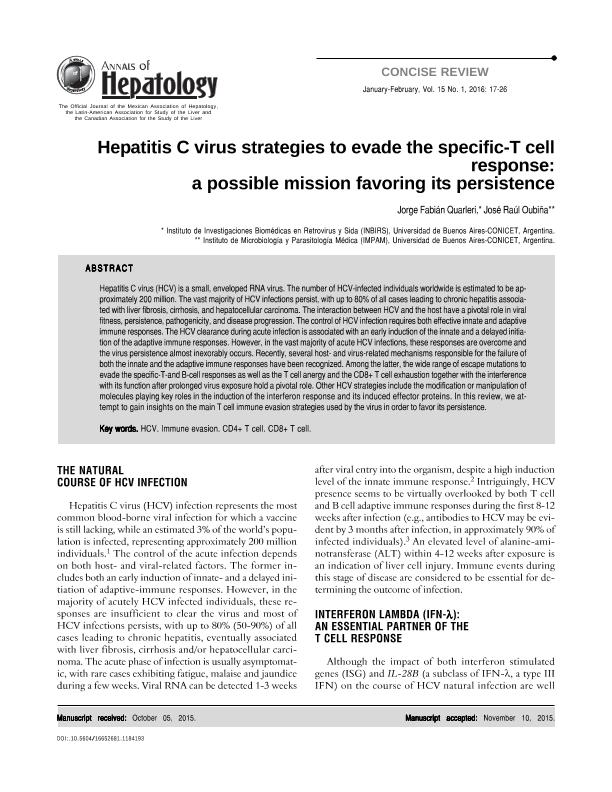Mostrar el registro sencillo del ítem
dc.contributor.author
Quarleri, Jorge Fabian

dc.contributor.author
Oubiña, Jose Raul

dc.date.available
2018-03-14T19:25:44Z
dc.date.issued
2016-01
dc.identifier.citation
Quarleri, Jorge Fabian; Oubiña, Jose Raul; Hepatitis C virus strategies to evade the specific-T cell response: A possible mission favoring its persistence; Mexican Association of Hepatology; Annals of Hepatology; 15; 1; 1-2016; 17-26
dc.identifier.issn
1665-2681
dc.identifier.uri
http://hdl.handle.net/11336/38779
dc.description.abstract
Hepatitis C virus (HCV) is a small, enveloped RNA virus. The number of HCV-infected individuals worldwide is estimated to be approximately 200 million. The vast majority of HCV infections persist, with up to 80% of all cases leading to chronic hepatitis associated with liver fibrosis, cirrhosis, and hepatocellular carcinoma. The interaction between HCV and the host have a pivotal role in viral fitness, persistence, pathogenicity, and disease progression. The control of HCV infection requires both effective innate and adaptive immune responses. The HCV clearance during acute infection is associated with an early induction of the innate and a delayed initiation of the adaptive immune responses. However, in the vast majority of acute HCV infections, these responses are overcome and the virus persistence almost inexorably occurs. Recently, several host-and virus-related mechanisms responsible for the failure of both the innate and the adaptive immune responses have been recognized. Among the latter, the wide range of escape mutations to evade the specific-T-and B-cell responses as well as the T cell anergy and the CD8+ T cell exhaustion together with the interference with its function after prolonged virus exposure hold a pivotal role. Other HCV strategies include the modification or manipulation of molecules playing key roles in the induction of the interferon response and its induced effector proteins. In this review, we attempt to gain insights on the main T cell immune evasion strategies used by the virus in order to favor its persistence.
dc.format
application/pdf
dc.language.iso
eng
dc.publisher
Mexican Association of Hepatology

dc.rights
info:eu-repo/semantics/openAccess
dc.rights.uri
https://creativecommons.org/licenses/by-nc-sa/2.5/ar/
dc.subject
Cd4+ T Cell
dc.subject
Cd8+ T Cell
dc.subject
Hcv
dc.subject
Immune Evasion
dc.subject.classification
Salud Ocupacional

dc.subject.classification
Ciencias de la Salud

dc.subject.classification
CIENCIAS MÉDICAS Y DE LA SALUD

dc.title
Hepatitis C virus strategies to evade the specific-T cell response: A possible mission favoring its persistence
dc.type
info:eu-repo/semantics/article
dc.type
info:ar-repo/semantics/artículo
dc.type
info:eu-repo/semantics/publishedVersion
dc.date.updated
2018-03-14T17:03:29Z
dc.journal.volume
15
dc.journal.number
1
dc.journal.pagination
17-26
dc.journal.pais
México

dc.description.fil
Fil: Quarleri, Jorge Fabian. Consejo Nacional de Investigaciones Científicas y Técnicas. Oficina de Coordinación Administrativa Houssay. Instituto de Investigaciones Biomédicas en Retrovirus y Sida. Universidad de Buenos Aires. Facultad de Medicina. Instituto de Investigaciones Biomédicas en Retrovirus y Sida; Argentina
dc.description.fil
Fil: Oubiña, Jose Raul. Consejo Nacional de Investigaciones Científicas y Técnicas. Oficina de Coordinación Administrativa Houssay. Instituto de Investigaciones en Microbiología y Parasitología Médica. Universidad de Buenos Aires. Facultad de Medicina. Instituto de Investigaciones en Microbiología y Parasitología Médica; Argentina
dc.journal.title
Annals of Hepatology

dc.relation.alternativeid
info:eu-repo/semantics/altIdentifier/doi/http://dx.doi.org/10.5604/16652681.1184193
dc.relation.alternativeid
info:eu-repo/semantics/altIdentifier/url/https://annalsofhepatology.publisherspanel.com/resources/html/article/details?id=127546
Archivos asociados
